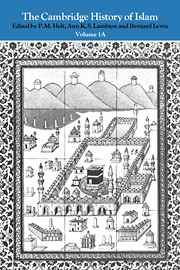3 - The Patriarchal and Umayyad caliphates
from Part I - The rise and domination of the Arabs
Published online by Cambridge University Press: 28 March 2008
Summary
The institution of the caliphate and the Ridda
There was great consternation in Medina when Muhammad died (13 Rabī‘ I 11/8 June 632). Nevertheless, the Muslims realized at once that they would have to choose a successor to the dead man. His successor could not be another prophet, since it was known by divine revelation that Muhammad was the Seal of the Prophets, but it was urgently necessary to choose a new head of the community. So, while the relatives, including his cousin and son-in-law ‘Alī, kept vigil by the body and made preparations for the burial—curiously enough, in the room where it lay—a numerous group of Companions gathered in a roofed enclosure, the saqīfa of the Banū Sā‘ida, to decide what should be done. The discussion was animated, and at times even violent, for the old antagonism between Medinese Helpers (Ansār) and Meccan Emigrants (Muhājirūn) flared up afresh, and the idea had been mooted that there should be one Medinese and one Meccan head, with consequences that would have spelt disaster for Islam. During a momentary pause, however, ‘Umar paid homage to Abū Bakr, Muhammad's intimate friend and collaborator, by grasping his hand as was the custom when a pact was concluded, and his example was followed by others. Abū Bakr thus became the successor (khalīfa) of the Messenger of God and in this way the caliphate was founded, an institution which had no equivalent—and was destined never to have any—outside the Muslim world.
- Type
- Chapter
- Information
- The Cambridge History of Islam , pp. 57 - 103Publisher: Cambridge University PressPrint publication year: 1977
- 1
- Cited by



